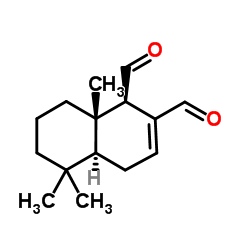(-)-Polygodial

(-)-Polygodial structure
|
Common Name | (-)-Polygodial | ||
|---|---|---|---|---|
| CAS Number | 6754-20-7 | Molecular Weight | 234.334 | |
| Density | 1.1±0.1 g/cm3 | Boiling Point | 330.7±35.0 °C at 760 mmHg | |
| Molecular Formula | C15H22O2 | Melting Point | N/A | |
| MSDS | Chinese USA | Flash Point | 124.0±22.9 °C | |
|
Screening for negative effects of candidate ascidian antifoulant compounds on a target aquaculture species, Perna canaliculus Gmelin.
Biofouling 29(1) , 29-37, (2013) The natural chemical compounds radicicol, polygodial and ubiquinone-10 (Q10) have previously been identified as inhibitors of metamorphosis in ascidian larvae. Accordingly, they have potential as a specific remedy for the costly problem of fouling ascidians i... |
|
|
Preventing ascidian fouling in aquaculture: screening selected allelochemicals for anti-metamorphic properties in ascidian larvae.
Biofouling 28(1) , 39-49, (2012) Fouling by ascidians causes major stock losses and disrupts production in marine aquaculture, especially bivalve aquaculture. Currently, no cost effective solution exists despite the testing of many prospective control techniques. This study examined a range ... |
|
|
Inhibition of the mitochondrial ATP synthesis by polygodial, a naturally occurring dialdehyde unsaturated sesquiterpene.
Biochem. Pharmacol. 70(1) , 82-9, (2005) Polygodial is a naturally occurring sesquiterpene dialdehyde that exhibits several pharmacologically interesting activities. Among them, its antifungal properties have been more thoroughly studied. The mitochondrial ATPase has been suggested as one of the pos... |
|
|
Antibacterial activity of polygodial.
Phytother Res. 19(12) , 1013-7, (2005) Polygodial was found to possess moderate antibacterial activity against gram-positive bacteria including Bacillus subtilis, Staphylococcus aureus and gram-negative bacteria including Escherichia coli and Salmonella choleraesuis with minimum bactericidal conce... |
|
|
Synergism of polygodial and trans-cinnamic acid on inhibition of root elongation in lettuce seedling growth bioassays.
J. Chem. Ecol. 29(10) , 2253-62, (2003) A bicyclic sesquiterpene dialdehyde, polygodial did not inhibit root elongation up to a concentration of 12.5 microg/ml in a lettuce seedling assay: trans-Cinnamic acid inhibited the elongation by 50% at 1.2 microg/ml (8.1 microM). The inhibitory activity of ... |
|
|
Multifunctional action of antifungal polygodial against Saccharomyces cerevisiae: involvement of pyrrole formation on cell surface in antifungal action.
Bioorg. Med. Chem. 13(24) , 6742-7, (2005) The antifungal activity of polygodial against Saccharomyces cerevisiae involves multifunctions. Polygodial first acts as a surface-active agent (surfactant) and then becomes involved in biochemical processes. The ability to form a pyrrole derivative with a pr... |
|
|
Comparative study on the larvicidal activity of drimane sesquiterpenes and nordrimane compounds against Drosophila melanogaster til-til.
Molecules 18(4) , 4192-208, (2013) Natural compounds from Drimys winteri Forst and derivatives exhibited larvicidal effects against Drosophila melanogaster til-til. The most active compound was isodrimenin (4). The highest lethal concentration to the larvae of D. melanogaster was 4.5 ± 0.8 mg/... |
|
|
Mioganal, a novel pungent principle in myoga (Zingiber mioga Roscoe) and a quantitative evaluation of its pungency.
Biosci. Biotechnol. Biochem. 72(10) , 2681-6, (2008) We isolated a novel pungent principle from the flower buds of myoga. Based on an interpretation of the HR-MS, EI-MS, IR, UV, and NMR data, this compound was (8betaH)-14,17-cyclolabda-12,14(17)-diene-15,16-dial (mioganal, 1). We determined the threshold value ... |
|
|
Effect of a novel phyto-compound on mucosal candidiasis: further evidence from an ex vivo study.
J. Dig. Dis. 8(1) , 48-51, (2007) To isolate, identify and determine the prevalence of yeasts in the oral cavity of individuals and to test the minimum inhibitory dilution (MID) of Kolorex against the yeasts isolated.Twenty-nine individuals of both sexes aged on average 61.3 years were evalua... |
|
|
Naturally occurring compounds affect glutamatergic neurotransmission in rat brain.
Neurochem. Res. 32(11) , 1950-6, (2007) Natural products, including those derived from plants, have largely contributed to the development of therapeutic drugs. Glutamate is the main excitatory neurotransmitter in the central nervous system and it is also considered a nociceptive neurotransmitter, ... |